Go to...  | Start A New Topic  | Search  | Notify  | Tools  | Reply To This Topic  |  |
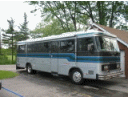 |
The tech who came out to our site to diagnose the problem we have with a fluctuating tach (actually the tach doesnt work at all on startup, but might jump into action after driving for 20 minutes or so?) and a voltmeter that only shows 11 volts on startup from cold, says the Powerline Solid State Isolator is whacked. ... Sooo! I Googled said Isolator and guess what I found?? ... Barthmobile!! ... Anyway, here I am waking up this old thread. Mac....(Medic37). Did you find that the problem was the Powerline Isolator? If so, did you find a replacement? Our's is the same as yours. 160 amps max. with 3 studs as you have outlined here. The center portion of the isolator where the cables hook up is cracked and deteriorating too. We also found the ground strap from the alternator to the frame was not hooked up! Guess it has been like that since we had a new/rebuilt alt installed about 18 months ago! Great! BTW. If I start the engine and turn off the master switch to the house batteries we found that the Tach suddenly worked and the voltmeter went from 11.5 volts at idle to 12.5 volts. ... Sound familiar? Looking for a remedy before we start the 2500 mile drive home in three weeks. Any help greatly appreciated! Don 1990 Regency 34' Cummins 6CTA 8.3 240hp Spartan Chassis, 4 speed Allison MT643 | |||
|
"Host" of Barthmobile.com 1/19 1/19 |
Until you get a new isolator... Run all of the cables to one stud - done. This is what I would do if this was an emergency roadcall and you were trying to get home. For myself, I have eliminated my isolator in favor of a parallel switch. The easiest way to describe it is the start batteries are charged by the alternator no matter what. The house batteries are brought online to charge whenever I throw a switch in the battery box. Most people would consider this a high amp cutoff switch. In reality, it parallels the house batteries to the main batteries with the alternator charging both circuits at all times when on. Disconnect by turning it to the left when parked. It gives you 100% charge with no voltage drop like an isolator would. 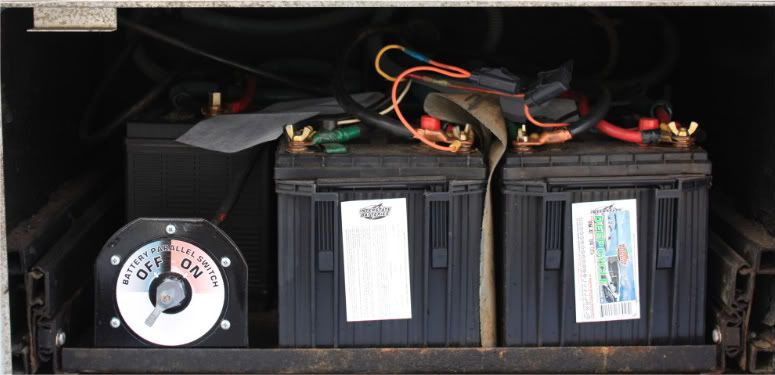
| |||||||||||||||
| ||||||||||||||||
I believe that you have a dead cell or something going on with your coach batteries. If you are getting a steady voltage reading with the house batteries "OFF" (not sure if that would take the house batteries out of the charging circuit)that suggests that there is a high fluctuating load on the house system or, a battery(s) problem. If you remove the house battery lead from the isolator, and the voltage is stable, that would answer the question. If the voltage still fluctuates, there are problems elsewhere. Isolators will fail either open,--- no current will flow thru--- or fail shorted, in which case the batteries or one set of batteries will be shorted to the alternator directly. in either case, this would not cause a voltage fluctuation, just an irregular charge etw2een the two sets of batteries. HTH Ed 94 30' Breakaway #3864 30-BS-6B side entry New Cummins 5.9L, 375+ HP Allison 6 speed Spartan chassis K9DVC Tankless water heater | ||||
|
Official Barth Junkie |
Sometimes those high current devices (like rectifiers in alternator diode bridges and isolators) may be heating up, cooling down and failing intermittently. I had intermittent charge fluctuations, turned out one of the slip ring brushes was cracked in the alternator and was making poor/variable contact with the slip ring. Replaced the alternator. The 60 amp ones are marginal in my opinion. They only deliver about 45 amps when hot and seem prone to heat failure. I now carry a (tested good!) spare. Otherwise, the infamous "bad connections" are notorious for strange symptoms. Last year I went from batteries to "aux start" relay to starter, then on to isolator and alternator. Many (most!) dubious connections along the way. I doubled or replaced some of the puny wires and installed the right side heat shield on engine. Result: went from slow hot cranking to cranking like the proverbial scalded dog. Still can't rule out batteries. I had a deep cycle on a trolling motor that would speed up and slow down like flipping a switch. I would have sworn it was a bad motor winding or external wiring connection but it was apparently a cell shorting internally. When I worked computer service the intermittent problems always drove us nuts. (Have you considered exorcism?) 9708-M0037-37MM-01 "98" Monarch 37 Spartan MM, 6 spd Allison Cummins 8.3 325+ hp | |||
|
 8/10 8/10 |
My postings regarding the situation with my TACH were nearly 5 years ago. Since that time I have replaced my Converter / Charger to an INTELI-POWER PD9170A (70 amp). I have also replaced my House Battery configuration to 2 6v GF Batteries wired in series and have cleaned-up some of the wiring to said items. As far as my TACH is concerned: To be perfectly honest, I don't know if it has ever behaved correctly. I don't believe I am still having the problem that was initially described in this post, but it does some just plain weird things at times. The coach is parked for winter at current. Interestingly enough, Minnesota is having the strangest, most mild winter I can remember in a very long time. Much warmer temps and very little snow. I have moved to a more rural property and have to deal-with an unpaved driveway, an unpaved parking area for the coach and about a mile of unpaved Township Road leading to my property. The roads are currently under weight restrictions and the frost [even tho there's not much] is starting to come out of the ground ...can make for some very unstable surface conditions. I will have the coach out of storage within week(s) and can hopefully, better describe some of the things the TACH is doing. Kinda bounces all over the place at times. I do need new Coach Battery(s). Currently have 2 8-Ds which have to be a minimum of 10 years old ...probably older. They will start the coach in warm weather. But, any temps around or below the 35 degree range, they will not even turn the engine over. If I plug-in and run the block heater, then it will pop-right-off. ***Suggestions on coach batteries???*** I plan to do this, too, ASAP, and hope to alleviate all battery concerns. I also like Bill's Parallel Switching configuration. Puts "you" at the controls, instead of a "black box" making random decissions. I am plugged-in most places I go, so it's just a matter of flipping a switch in the order of going to shore power. Maybe should just replace the TACH??? I know that ALL of these items [Batteries - Parallel Switching - Converters - TACHs] have all been discussed at length in other posts and the information is "in here". ~Mac~ 1990 31 Foot Regency Spartan Chassis Cummins 6CTA8.3 Alison MT643, 4-speed 8905-0123-31RDS-A2 | |||
|
"5+ Years of Active Membership" 9/11 9/11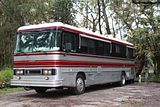 |
I had a past problem with maintaining the battery with all the lights on and the alterator was only putting out 11 volts. I replaced my 130 amp Leece-nevill with a 160 amp Delco. This was done out of town and the guy doing it said this is the alternator the local fire trucks and ambulances use. He also removed the isolater and put in solenoid instead. He said I was also losing power thru it. This worked great and I was back a 13 volts. On the way home found that I no longer had cruise control, a tach reading or a speedometer. The reason was found to be the Delco is a one wire and I need a two wire to make the above items work. I've been told I can get the Delco converted to a two wire and correct the problems. I still have the old L/N alternator. Can it be rebuilt to put out 160amps? The only reason I ask is one RV repair guy said some motorhomes are designed to work with just the Leece-Nevill. OK don't laugh cause I don't know if that is true. Jim 1985 Barth Regency 35ft DD 225hp Ally-trans-4 speed | |||
|
FKA: noble97monarch 3/12 3/12 |
The problem with a diesel is there is no ignition for the tach (and other engine speed devices) to read engine speed. The alternator provides a consistent speed variable, once calibrated, but there are other methods used like a Hall sensor. A clever mechanic can probably "jury rig" a pulse from the new single wire alternator, but you may also be able to rig up a Hall sensor somewhere too. That would mean buying a different tach. A lot of the newer diesels are running two smaller alternators to get required output. Just one more possibility.  Formerly: 1997 Barth Monarch Now: 2000 BlueBird Wanderlodge 43' LXi Millennium Edition DD Series 60 500HP 3 stage Jake, Overbuilt bike lift with R1200GS BMW, followed by 2011 Jeep Wrangler Unlimited, “I haven’t been everywhere, but it’s on my list.” | |||
|
 |
Thanks for the quick response and great ideas. Mac: I get from this that you have installed a new Converter/Charger but the old Powerline Isolator is still in there? Until this happened on the drive down here (Arizona) eveything worked great. The coach batterys always showed charged on the control panel over the door. (two 12V deep cycle new in 2009) The two 12V start batts are new 2010 and the tech tested all of them and said they are all good. The tach on this thing has always worked perfectly and did so when we bypassed the house batts by turning off the master switch. About the only time we are not plugged in would be an overnight at a Walmart. Billny. I like your manual switch. BUT!!... to clarify!! ... DOES IT MATTER WHICH POST I ATTACH ALL THESE HEAVY CABLES TO, ... there a 2 cables to the top stud 4 on the bottom stud and one to the centre stud?? As a side note. The Barth doesn't get out much in the summer. It sits in the driveway and gets excercised about once a month from April to mid November plus we usually get out a couple of weekends. I usually turn off the master switch by the steps when not in use. After a month the house batts will show about half charge so there is still a slow drain. Plugging in to the 20A plug near the driveway will bring them up again. So will a good drive down the highway. At least that's how it was in previous years. BTW the new/rebuilt alternator is 160 amp as called for by Barth. This RV electrics are way over my head so I really appreciate all your comments and help. We love our Barth! Don
1990 Regency 34' Cummins 6CTA 8.3 240hp Spartan Chassis, 4 speed Allison MT643 | |||
|
"Host" of Barthmobile.com 1/19 1/19 |
It would help if you could tell me where your cables are, in relationship to the batteries and isolator and pictures of your setup.
| |||||||||||||||
| ||||||||||||||||
 8/10 8/10 |
Bill: Did you post a diagram of your Parallel Switch at some point in time??? I did pull the BUS out of storage yesterday. We had a cold day and the ground [mudd] was firm, so it is now 10 miles from here sitting in the driveway at my other house ...now in the land of pavement! I want to get to work on those coach batteries ASAP. I'm thinking that a previous post indicated that 2 - 8D batteries was not required for a Cummins 8.3. ***What are the options for starter batteries???*** "Yes"... the Isolator is still there and I think I will elininate that thing this spring. My TACH seemed to work normally during the 10 mile drive yesterday. When the coach is shut-down it will park itself [the TACH] in a weird position and sometimes while at highway speeds, it seems to act erratically. Is a TACH difficullt to replace??? ~Mac~ 1990 31 Foot Regency Spartan Chassis Cummins 6CTA8.3 Alison MT643, 4-speed 8905-0123-31RDS-A2 | |||
|
 |
I hope this works! These pics are of the Powerline Isolator taken thru the curbside compartment door. The engine start batts can be seen at bottom left. According to the sticker on the side of the unit the top post is "Main Battery" the middle post is marked "B" and according to my tech is hooked up to the alternator. The bottom post is marked "Auxiliary Battery". So, as much as I can see it and follow the cables this what I can see. The top post has one cable to that solenoid looking thing to the right of the isolator. A second cable goes to the engine start battery positive post and is visible in the pics. I guess the middle post cable goes to the alternator as the tech says, but I could not follow it there when under the coach. The bottom post has two cables that disappear into a maze that heads towards the front of the coach and one cable that goes to a second post on that solenoid like thing. The fourth cable goes up and across to the street side rear where the house batts are located but again I can't follow it because of the maze of wires! This stuff baffles me! Thanks again. Don 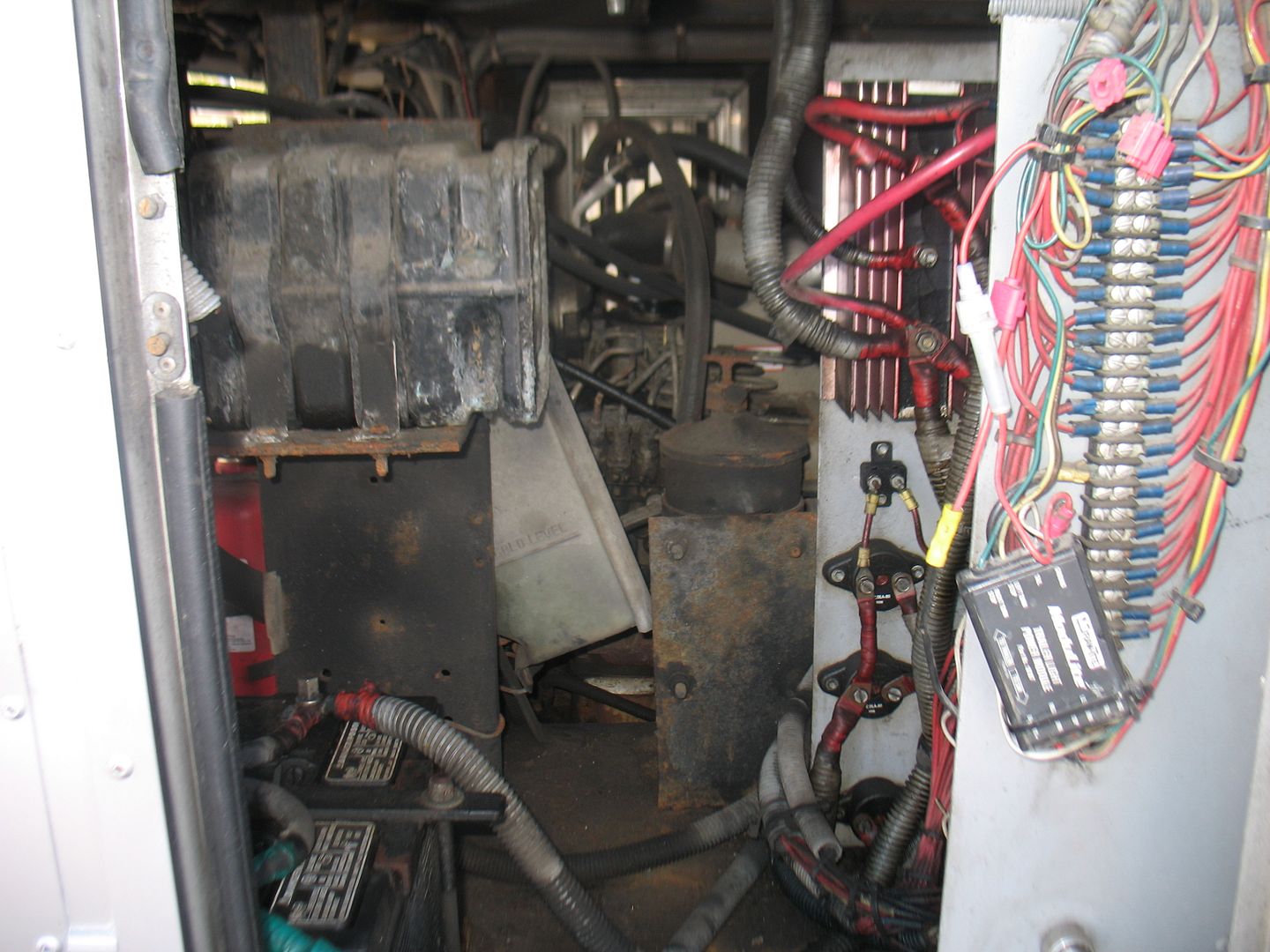 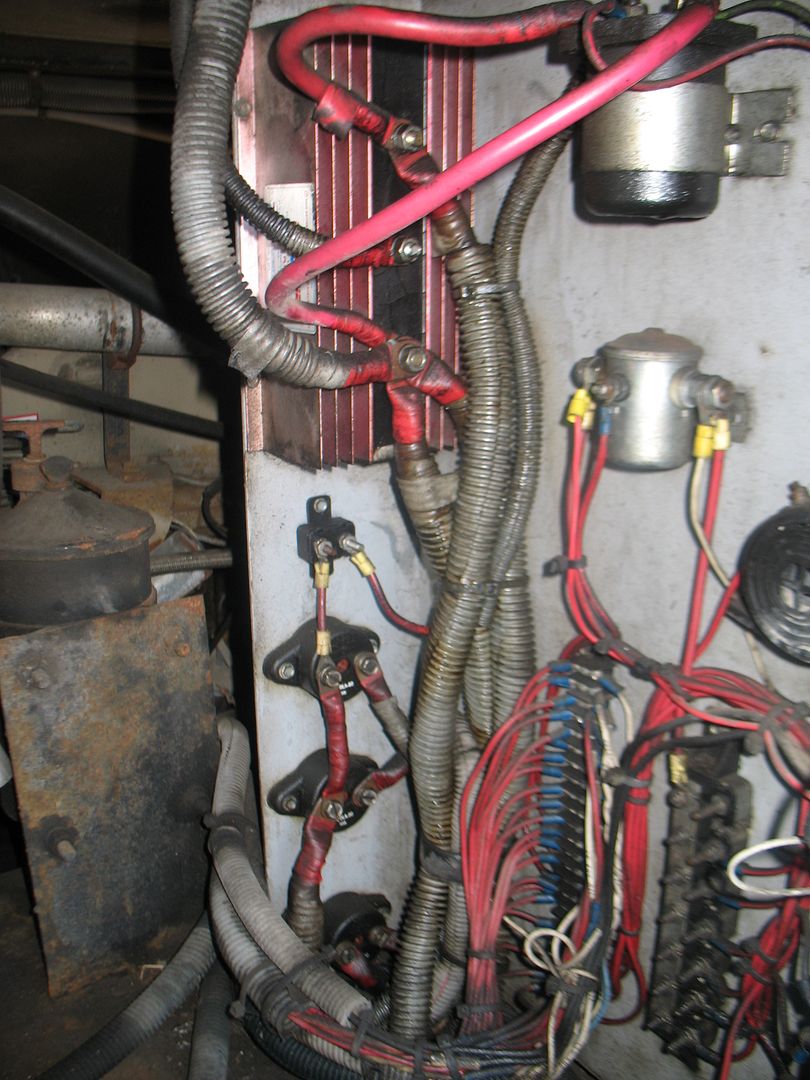 1990 Regency 34' Cummins 6CTA 8.3 240hp Spartan Chassis, 4 speed Allison MT643 | |||
|
Don, That solenoid with a wire from each post of the isolater is your paralleling solenoid that ties the two sets of batteries, ( coach and house) when the Bat "AUX" switch is pushed. I do not believe that there is any problem with the isolator. I said it before I believe that there is a problem with your house batteries or some extreme load on the house system. As reported your symptoms seem to go away when you switch off the house battery system. That would have nothing to do with the isolator. If you are off line, with no shore power and the generator not running, House batteries on line, what is the house battery voltage. Is it steady or varying? If you connect shore power and the battery charger starts charging, what is the voltage, does it vary or steady reading. I will be going thru Phoenix Mar 17-18 on my way to Texas. if you are still there, I certainly would stop and visit with you. I could review then if not too late for you. Ed 94 30' Breakaway #3864 30-BS-6B side entry New Cummins 5.9L, 375+ HP Allison 6 speed Spartan chassis K9DVC Tankless water heater | ||||
|
"Host" of Barthmobile.com 1/19 1/19 |
I would take him up on this offer... Can't do better than this. My problem with isolators is the voltage drop. I would rather be in control of my electrical system. I believe that running the alternator to the start battery is better for that reason. I would only parallel my batteries while running down the road and disconnect them while parked. If you can be disciplined enough, then you won't have a problem. Let Ed check your system for you.
| |||||||||||||||
| ||||||||||||||||
Official Barth Junkie |
You have a strong argument in my opinion. The 0.6 volt drop through the isolator tends to undercharge. After an extended run, my convertor will still "top off" the charge on the coach batteries when I connect to shore power. The "charge wizard" apparently wants that extra .6V Since the coach batteries are deep cycle and the crank battery isn't, there must be some compromise when they are ganged together. I have been lead to believe the two types have different charging needs. I am thinking of the crowbar method to replace my isolator. A heavy duty, continuous duty relay could be used as a "remote knife switch," with relay energized only when charging from engine. Good luck, hopefully Ed will sort it out! 9708-M0037-37MM-01 "98" Monarch 37 Spartan MM, 6 spd Allison Cummins 8.3 325+ hp | |||
|
 |
Thanks again guys. Ed. It being Sunday, we are kinda booked up with the daughter and grandson coming over for breakfast and a swim but I will check out your tests on the house batts later on today. I will also get you my phone number now. Thanks Don 1990 Regency 34' Cummins 6CTA 8.3 240hp Spartan Chassis, 4 speed Allison MT643 | |||
|
| Powered by Social Strata | Page 1 2 3 4 |
| Please Wait. Your request is being processed... |
|
This website is dedicated to the Barth Custom Coach, their owners and those who admire this American made, quality crafted, motor coach.
We are committed to the history, preservation and restoration of the Barth Custom Coach.
We are committed to the history, preservation and restoration of the Barth Custom Coach.



